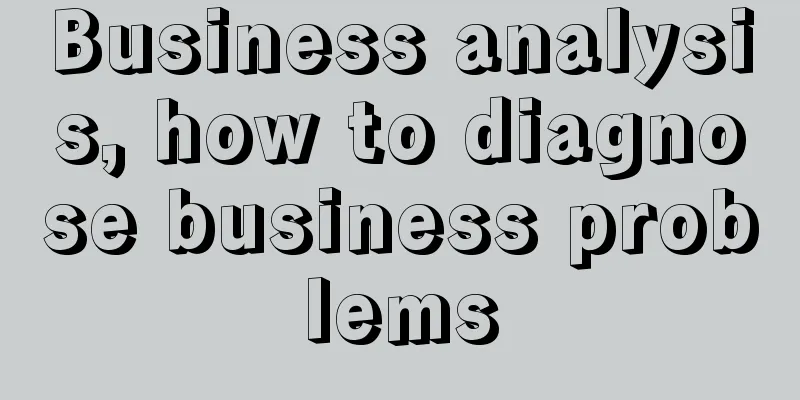Business analysis, how to diagnose business problems

Diagnosing business problems is a basic requirement for business analysis and data analysis for many companies, and is also one of the three basic methods of data-driven business. Among data analysis methods, business problem diagnosis is a typical "easy to see, but wrong when you do it". Many students are troubled: "Why doesn't the business side recognize the problem analysis I did?" Today I will give a systematic answer to this question. 1. Common PracticesThere is a standard process for business diagnosis:
Let's take a simple example: a company has 4 sales business lines, and set a monthly sales target of 100 million, but actually achieved 95 million, which is below the target. The performance of the four lines is shown in the following figure. It can be easily seen that there is a problem with channel A (as shown in the following figure). If the sales are online, you can further see the conversion process and diagnose which link has a problem (as shown in the figure below). Therefore, a common diagnostic suggestion is: "We found that there is a problem with business line A, and the conversion rate of its delivery is too low. It is recommended to increase it." This is the common practice. The problem is that many students who do this will get comments like "What you said is nonsense!" They feel so wronged. But what is the problem? 2. Frequently Asked QuestionsThe problem with conventional practices comes from: just talking about numbers and staying on the surface. Doing so is like a patient going to the doctor and the doctor saying, "Your temperature is 38 degrees. I suggest you lower it." If you were the patient, you would also slam the table and say, "I knew I had a fever! What should I do?" Simply listing data is not problem diagnosis, at best it is problem discovery. The problem diagnosis that the business side expects to hear should point to a specific business action. Taking Company A as an example, the business side expects to hear the following diagnosis results (as shown below). Many students who work with data will have their heads buzzing when they see this. These things are too emotional. How can they be associated with indicators such as DAU, conversion rate, active rate, and consumption amount? 3. Key to solving the problemWhen using data to drive business, the most feared thing is that the business side will say: "If you can do it, then do it. If you can't, don't talk nonsense." Especially when using data to raise questions, the business side will instinctively fight back. Either they will blame the environment, upstream and downstream departments, or ask for resources, or they will use the ultimate killer weapon: "I know what you said, I have done it, it doesn't work, if you don't believe me, you do it." If the business side is determined to argue with the data analyst, the data analyst is very weak and will definitely not win the argument. Therefore, in essence, diagnosing a problem is diagnosing the business side's concerns. Only by clearly distinguishing who is truly willing to improve the problem can we prescribe the right remedy. There are four key points of distinction:
These four key points can distinguish whether the business party really wants to solve the problem and the direction in which the business party intends to solve the problem. When diagnosing business problems, you can first consider the results of common practices, then confirm these four key points one by one, and gradually derive the diagnostic results. 1. Distinguish whether you really understand the current situationIt is very likely that the business side only knows that the overall situation is not good, but does not know which specific part has gone wrong. And the business side's instinctive reaction is also based on overall cognition. Therefore, present the content of common practices first to let the business side see the problem points clearly. If the business side has not seen the details beforehand, they may have an idea to solve the problem after seeing the details. There are two basic strategies (as shown below), and the data analyst can add the corresponding reference data to assist in the judgment. At this step, the diagnosis is completed. It is also possible that the business side already knows the details, so we can proceed to the next step. 2. Distinguish whether action has been takenNote that taking action but not seeing results is completely different from not taking action. If the business side has not taken action, it is worth questioning: "Why don't they take action when they clearly see the problem???" It is very likely that the business side will think the problem is not important and it will disappear naturally in time. At this point, you can review the historical data, find similar scenarios, and after reaching a conclusion, make judgments based on the current situation (as shown in the figure below). This situation is still easy to handle, because when the business party has no plan, they will not strongly oppose the reminders/suggestions of others. What is really difficult to deal with is: when actions have been taken but have not been effective. At this time, it is best if the diagnostic conclusion presented to the business side is one that they have never heard of and is very effective. Otherwise, you will definitely be criticized: "What's the use of what you said! I just tried it!" Be especially careful when drawing conclusions at this time. 3. Distinguish whether there is an action planWhen actions have been taken but have not been effective, the business side's instinctive reaction is to ask for resources. It is normal to ask for larger shells when you can't win a war. But the boss's instinctive reaction was: Think about it again. Your method must be wrong. If you don't believe me, I will replace Li Yunlong and he will definitely defeat the Yamazaki Battalion. This contrast often results in plans to directly apply for resources being rejected. If resources cannot be applied for, the business department may choose to pass the buck, saying that it doesn’t matter whose problem it is, as long as it’s not my problem. At this time, the problem is extremely complicated for data analysts. If data analysts rashly express their opinions, they are likely to be classified as "hostile elements". No matter what the data analysts say, people will simply oppose them for the sake of opposing them. So don't take the initiative to express your opinions at this time. Instead, analyze the options that may solve the problem/pass the buck in advance, and finally hand it back to the business/boss for judgment. Common options for shirking responsibility include:
Common problem-solving options, such as:
Each of the above points is a special topic analysis, and there are too many contents to list them one by one here. However, if you want to help the business department in trouble to find a way out, it is worth spending more energy. Or you can use a simple method: benchmark analysis. Pick out a benchmark that can be copied and copy it directly. This saves a lot of trouble. This is why we introduce benchmark analysis first and then problem diagnosis. Some business departments are just too lazy to listen to theories. They like to say, "Just tell me who is doing well and I will copy him. OMG!" For benchmark analysis, see: Classical methods of data analysis: Benchmark analysis IV. SummaryEssentially, the difficulty in diagnosing a problem lies in two aspects:
The so-called "misfortunes never come singly" is exactly this situation. At this point, it is easy to describe the problem with data. You can see the gap by setting a benchmark. If you want to use data to diagnose the problem, you have to break through the layers of obstacles above and win the support of the business and the understanding of the boss before it can be effective. This is the only way from data to implementation. Is there a simple and easy way to implement it? Of course there is! The simplest one is that the business/data/boss says, "I have a good idea!" Since you already have a good idea, you can directly test the effect, which is the so-called data experiment method. Author: Down-to-earth Teacher Chen WeChat public account: Down-to-earth Teacher Chen |
>>: 2023, the year of the explosion of new tea drinks going overseas丨Annual observation
Recommend
How to apply for a flash sale on Amazon's new products? What's the method?
On the Amazon platform, many Amazon listings will ...
The entrepreneur's IP has not yet been created, but the successor's IP has already become popular
I don’t know if you have seen Towel Boy’s short dr...
How to cancel after being tricked into registering on Amazon? Is there any risk in working part-time on Amazon?
Some people may be deceived by criminals to regist...
Can I withdraw the money from my Amazon account after it is deactivated? How can I cancel my Amazon account?
Sometimes a seller’s Amazon account may be deactiv...
Merchants trapped in traffic flock to Xiaohongshu
A large number of businesses have flocked to Xiaoh...
What is the entry process for new Amazon sellers? Share the necessary conditions for entry
With the booming development of e-commerce, more a...
E-commerce bifurcation: Taobao, Jingdong and Douyin compete on price, while video accounts compete on brands
Video accounts are gradually moving towards a more...
This batch of college students talks about cyber romance at Gu Ming
This article mainly discusses how the new tea beve...
Which payment method is better on eBay? How do eBay sellers set up payment methods?
As a seller on eBay, it is crucial to choose the r...
A dance video has received tens of millions of likes. Can Xue Baobao become the next Zhong Meimei?
This article starts with the recently popular Douy...
Bloggers who "read books in groups" are stuck in monetization
In today's era of social media and content cre...
How is the eBay cross-border e-commerce platform? Features and advantages of the eBay platform
With the rapid development of the global economy a...
The milk tea charging joke has become a reality, and Ele.me has made Beijing subway popular
What are your ideas for post-holiday marketing? El...
What is the size of Amazon's main image? What are the main image requirements?
Amazon, as a cross-border e-commerce platform, is ...
Is it really difficult to commercialize AI?
Although products such as ChatGPT have shown great...









